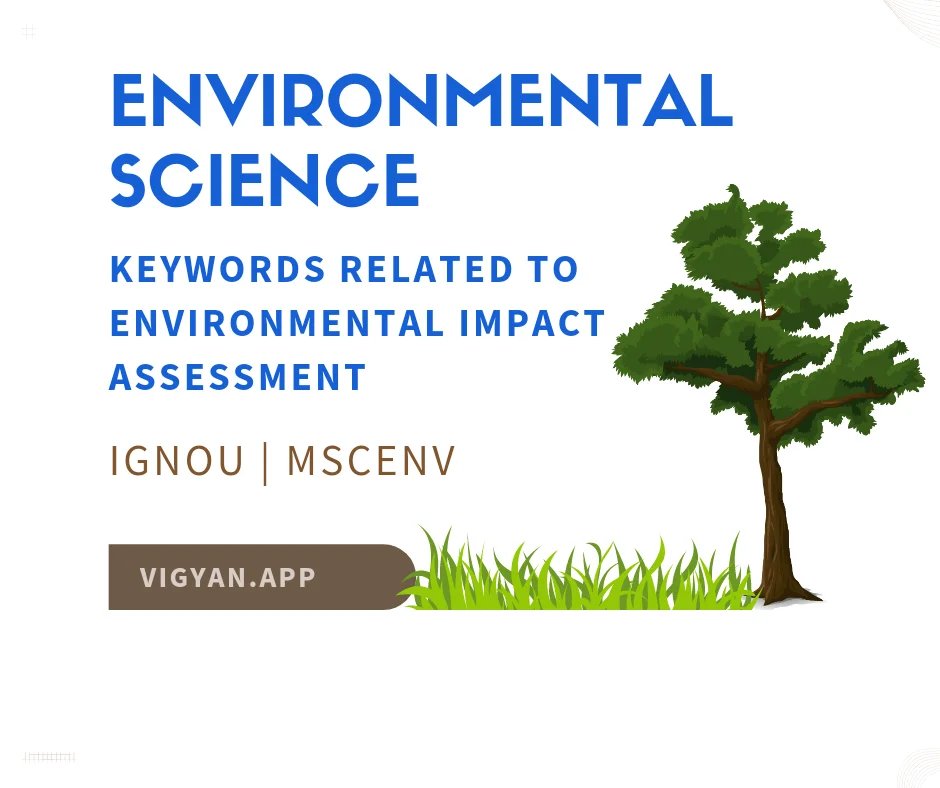
Some Keywords related to Environmental Impact Assessment
Environment Impact Assessment (EIA): It is a process of assessing the likely environmental impacts of proposed project or developmental activity, considering the interdependent socioeconomic, cultural and health effects, both positive and negative.
EIA Report: The EIA Report is a compilation of important project components, including the project description, assessment of its environmental and social impacts, mitigation measures, and related management and monitoring plans.
EIA Review Process: It is the mechanism which is undertaken to validate the quality of data and methods used in the EIA and to confirm whether or not the EIA report addresses all important mitigation measures.
Environmental Management Plan (EMP): It is tool which is used to confirm that unwarranted or judiciously preventable harmful impacts of a project are prevented
Quality Management System (QMS): It is defined as a formal system that details the processes and duties for realizing the quality strategies. It is a framework of procedures to realize the quality objectives of organization’s reliability in meeting the requirement of client.
EIA Clearance Procedures: It is the process which covers the aspects of screening, scoping, and assessment of any project/developmental activity, likely to affect the environment.
EIA Notification 1994: The EIA Notification 1994 was enacted under the Environment Protection Act, 1986 for safeguarding the developmental projects and ascertaining their environmental impacts as a part of planning and designing.
Environmental Impact Statement (EIS): It is a document that explains the impacts of a proposed action on environment.
Ecological Risk Assessment: It is the process which evaluates the probability that a developmental project activity will result to offer a measurable basis for harmonizing and relating risks linked with the ecological problems.
Exposure Assessment: It identifies the nature and size of the population(s) exposed to the risk agent, along with the magnitude, duration, and spatial extent of exposure. This process identifies the nature and size of the population(s) exposed to the risk agent, along with the magnitude, duration, and spatial extent of exposure.
Human Risk Assessment: It is process of identifying, evaluating, measuring, displaying and communicating the risks that could prevent the impacts of any developmental activity or project.
Project Planning: It is the process which defines the goals and scope, and milestones/ deliverables, and allocates the tasks and financial resources for each step of a project/ activity.
Risk Assessment: It is defined as a process which considers the possibility of incidence of harmful effects owing to the exposure to stressors from various anthropogenic activities.
Risk Characterization: It is the process of estimating the incidence of a health effect under the various conditions of human exposure described in exposure assessment.
Risk Evaluation: It is an assessment of implication of assessed risks, and normally involves estimation of apparent risk and benefit.
Risk Management: It involves decision making regarding the suitability of risks, and executing mitigation actions to diminish or reduce risks as part of an iterative cycle.
Checklist: These are complete lists of environmental effects and impact indicators are evolved to inspire the analyst to consider broadly about the probable effects of expected actions.
Consequence Assessment: It determines the probable degree of gravity of harm and is a process of scheming and assessing the linkage between exposures to a risk agent and the health or environmental impact of exposure.
Exposure Assessment: It is a process of assessing the magnitude, frequency and duration of exposure to an agent, along with the number and features of population exposed.
Fault Tree Analysis: It is a logical process used to determine various combinations of system failures and human errors that could cause detrimental events, referred to as top events at the system level.
Release Assessment: It is a rational process which quantifies the degree to which a risk source releases or else presents the risk agents into the human environment.
Risk Assessment: It is a process of identification, characterization and evaluation of risk.
What-if Analysis: It is an analytical method in which an expert group identifies probable uncommon circumstances, their consequences, prevailing safeguards, and then suggests options for decreasing the risks.
Sustainable Development: A development concept that human societies must live and meet their needs without compromising the ability of future generations to meet their own needs.
Legislative Act: A formal act of the legislature in written form. A legislature is a kind of assembly with the power to pass, amend and repeal laws. Statutory laws are the basic framework of the modern legal system.
European Commission (EC): Itis the executive branch of the European Union. responsible for proposing legislation, implementing decisions, upholding the EU treaties and managing the day-to-day business of the EU.
Protocol: The official procedure or system of rules governing affairs of state or diplomatic occasions.
Geographic Information System (GIS): A framework for gathering, managing, and analyzing data. Rooted in the science of geography, GIS integrates many types of data. It analyzes spatial location and organizes layers of information into visualizations using maps and 3D scenes.

